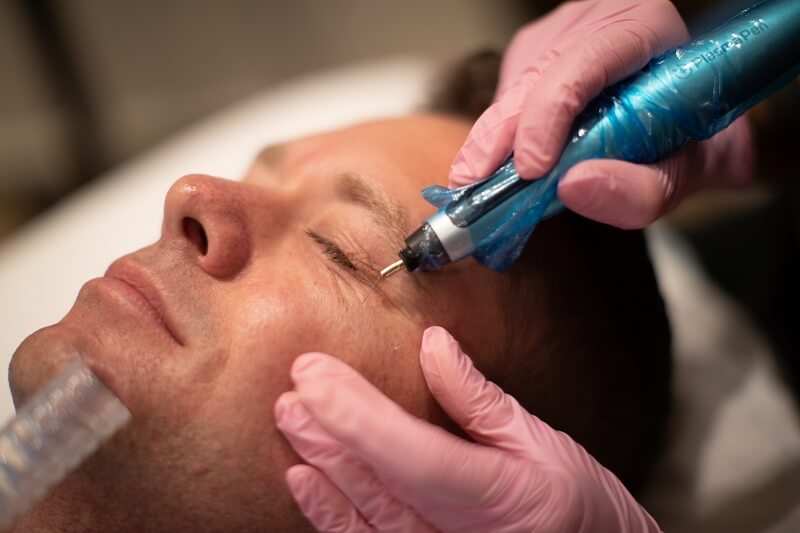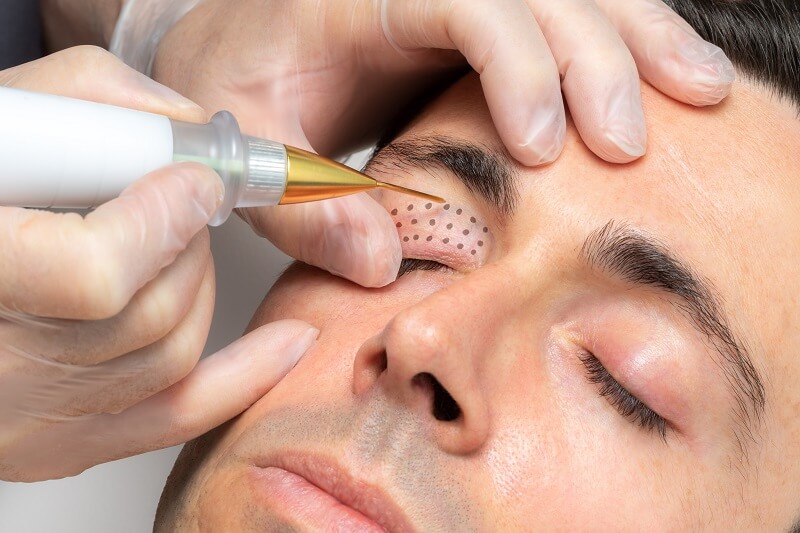For most people, the first signs of skin aging appear in their mid-20s, with fine lines around the eyes and a slight dullness of the complexion. These signs become more pronounced over time but are still reversible with the right skincare products and cosmetic treatments like Botox and dermal fillers.
The Plasma Pen is a newcomer among anti-aging cosmetic treatments, with benefits equal to those of surgical facelifts.
This article explains how the Plasma Pen works and what to expect from the treatment.

What Is the Plasma Pen?
The Plasma Pen or plasma fibroblast therapy is an innovative anti-aging treatment that stimulates the activity of fibroblasts, that is, collagen-producing cells in the connective tissue.
Note: Learn about the role of collagen in the skin.
This non-invasive, non-surgical cosmetic treatment is typically performed at a clinic or medical spa. It targets fine lines, wrinkles, and sagging skin, and leaves a visibly rejuvenated, tighter, and lifted appearance.
How Does the Plasma Pen Work?
Plasma fibroblast therapy involves using a pen-like device that sends a controlled electric current or plasma arc (thermal energy mixed with oxygen and nitrogen) to the skin. The provider holds the device about 1 mm above the surface of the skin while the electric current causes micro-injuries.
The scabs that appear due to the injury, also called carbon crusts, contract the skin and leave an instant tightening effect as the body produces more collagen and elastin to heal. The tiny scabs disappear after about ten days, while the treated area is left tightened, smoothed, and youthful.
Note: Read our article on collagen vs. elastin to learn how these two proteins differ and how to increase them.
Plasma Pen Benefits
Plasma fibroblast therapy provides many aesthetic advantages, much like those after surgical lifts but without knives and anesthesia.
The most prominent benefits include the following:
- Skin tightness. The after-procedure effects include taught, elastic skin that is firmer and has a visibly improved texture.
- Skin repair. The boost in collagen and elastin production regenerates the skin by triggering cell renewal and epidermal repair.
- Lifted skin. The treatment reduces skin laxity and lifts drooping eyelids, sagging jowls, and loose neck folds, creating a more youthful appearance.
- Smooth under-eye area. The device tightens the skin around the eyes, targeting fine lines and creases, and minimizing dark circles and puffiness in the undereye region.
- Wrinkle reduction. The pen effectively reduces lines, creases, and wrinkles, such as crow’s feet, forehead lines, marionette lines, and nasolabial folds.
- Stretch marks reduction. The treatment does not specifically target stretch marks, but it can decrease their visibility by reducing loose or sagging skin through collagen synthesis.
- Loose belly skin reduction. The Plasma Pen minimizes the appearance of loose belly skin (e.g., the postpartum pooch) by contracting the skin through collagen stimulation.
- Loose arm skin tightening. The device can also address skin laxity in the under-arm area that typically occurs after a sudden or significant weight loss.
- Scar tissue reduction. The procedure is commonly used for treating acne and post-injury scars. The device can reduce skin discoloration, improve uneven skin texture, and fill in mildly depressed lesions, such as atrophic scars.
- Age spots and sunspots reduction. The controlled micro-injuries induce collagen remodeling and promote skin cell renewal that can mildly improve skin tone. However, the process does not specifically target pigmentation issues.
- Added lip volume. The Plasma Pen provides a subtle plumping effect, defines lip contours, and enhances the overall appearance of lips by smoothing out the surrounding creases and wrinkles.
- Long-lasting results. The treatment itself does not stop the aging process, but the results are durable and may last up to 3 years.
Plasma Pen Treatment Areas
Plasma fibroblast therapy can be used on any area of the face and body.
The Plasma Pen most commonly treats:
- Drooping eyelids
- Frown lines
- Crow’s feet
- Nasolabial folds
- Marionette lines
- Sagging jowls
- Loose arm skin
- Loose belly skin
- Neck folds

What Skin Conditions Does the Plasma Pen Treat?
The procedure is suitable for various skin conditions, including the following:
- Reducing wrinkles, creases, and fine lines (e.g., crow’s feet)
- Tightening sagging skin (e.g., hooded eyelids, loose skin after pregnancy)
- Improving the appearance of acne scars
- Fading age spots or sunspots
- Reducing stretch marks
- Treating melasma
- Improving skin texture
- Removing flat warts
- Treating seborrheic keratosis
- Removing moles and skin tags
- Treating broken capillaries (e.g., spider veins)
Who Is a Good Candidate for Plasma Pen Treatment?
The Plasma Pen is safe for most healthy adults with a pale to white skin tone that can tan. Individuals with a darker complexion are more prone to pigmentation issues and may require further examination.
A serious medical issue will disqualify you from having the treatment. Your chosen medical provider will examine your medical history during the consultation session to determine your eligibility.
For your own safety, please disclose information about any medication you are taking.
Note: Learn how to rejuvenate skin and discover the best rejuvenating skincare products.
Who Should Avoid the Plasma Pen?
Some of the conditions that disqualify you from a Plasma Pen treatment are:
- Pregnancy
- Lactation
- Allergies
- Autoimmune disorders
- Uncontrolled diabetes
- Blood pressure issues
- Bleeding disorders
- Keloid or hypertrophic scarring
- Skin disorders (psoriasis, eczema, pigmentation disorders)
Note: If you're looking to treat inflammatory skin conditions (such as eczema or rosacea), check out our guide to holistic eczema treatment or discover natural treatment options for rosacea.
What Can You Expect During the Plasma Pen Procedure?
The Plasma Pen-trained medical provider first cleans your skin and applies a topical numbing cream to minimize pain and discomfort during the procedure. Then, they use the Plasma Pen device to deliver high-frequency electric current to the target area. After the procedure, the medical provider applies a cooling gel to soothe the irritated skin.
The procedure lasts about an hour, depending on the size of the treated area.
How Painful Is Plasma Pen?
Patients describe the pain level during a Plasma Pen treatment as mild to moderate. The topical numbing cream significantly decreases pain and discomfort.
Plasma Pen Results
Patients usually notice tightened and rejuvenated skin as soon as the carbon crusts fall off. These effects get better over the following weeks as collagen builds up gradually.
How Long Does It Take to See the Results from a Plasma Pen Treatment?
Mild skin-tightening changes are immediately visible, while full results take 8 to 12 weeks. Some patients require only one treatment for full results, while those with more prominent signs of aging need two or three.
How Long Do the Effects of Plasma Pen Last?
The results of the Plasma Pen treatment are permanent.
Patients return for a new treatment after three to five years because the natural aging process has continued, not because the results of the initial treatment have disappeared.
Plasma Pen Aftercare
The effectiveness of the Plasma Pen treatment and the recovery speed depend on your adherence to aftercare instructions.
Follow these tips for the most optimal results:
- Refrain from exercising for 24 hours.
- Don’t wear make-up until the crusts fall off.
- Don’t pick at the crusts or apply any pressure.
- Sleep on your back for several days.
- Avoid direct exposure to the sun and heat sources for 12 weeks.
- Use only cosmetic products recommended by your medical provider.
- Apply a gentle moisturizer to hydrate the treated area.
- Apply cold compresses to the irritated skin to reduce swelling and itchiness.
- Wear sunscreen (SPF 30+) whenever you leave the house.
Note: Learn more about how to choose sunscreen for your skin type and concern.
Plasma Pen Side Effects
Plasma Pen side effects are mild and typically resolve within two weeks.
They include the following:
- Swelling
- Redness
- Bruising
- Skin sensitivity
- Skin tightness
- Itching
- Peeling
- Crusting
- Sagging skin (e.g., upper eyelids)
Serious complications are rare and typically include the following:
- Prolonged discomfort
- Scarring
- Infection
- Herpes
- Hyperpigmentation
Plasma Pen Cost
The cost of a Plasma Pen treatment depends on the medical provider’s expertise, the extent of the skin issue, the size of the treatment area, and the desired results.
Prices range between $400 and $1900. Contact Vibrant Skin Bar to schedule a free consultation and find out the cost of your customized treatment plan.
Vibrant Skin Bar offers the most advanced Plasma technology in a powerful 8-series package with a complimentary Liposomal Vibrant C supplement.
Should You Perform the Plasma Pen Procedure by Yourself?
Experts recommend scheduling the procedure in a professional medical setting as a safer option than an at-home treatment.
A well-trained, certified skin specialist uses sterile equipment, reducing the risk of infection or permanent skin damage, such as scarring or hyperpigmentation.
Conclusion
We can’t stop the aging process completely, but we can continue to enjoy vibrant, youthful skin thanks to non-invasive procedures like the Plasma Pen.
If you don’t want to have surgery and you wish to avoid the needles that come with Botox and fillers, the Plasma Pen may be the right treatment for you.


